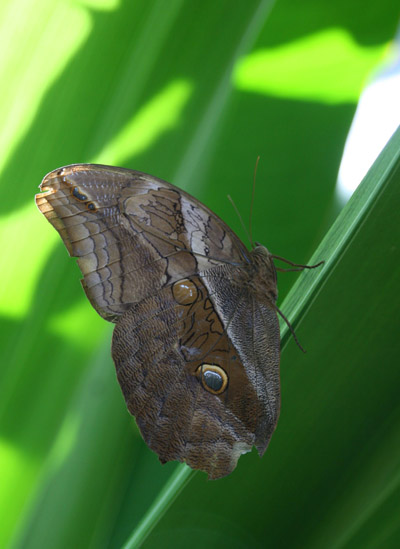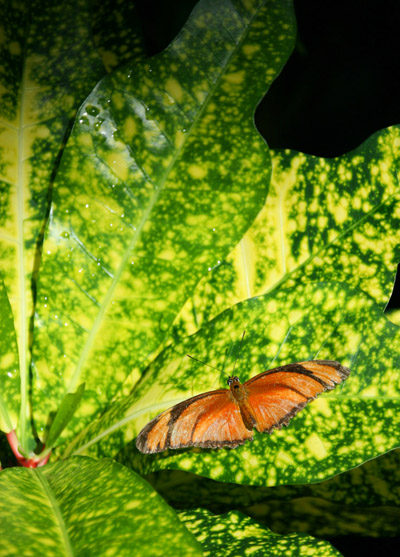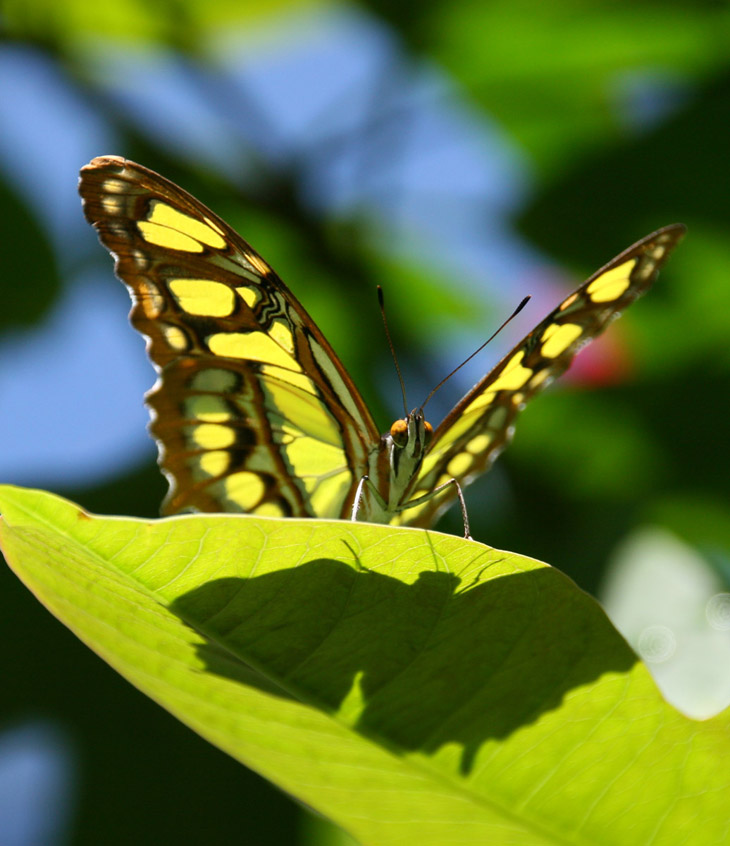
That was absolutely terrible, I admit it – I really need to stop doing such things if I want any readers at all. The only thing I meant by it was, in the winter when any kind of photographic subject matter is scarce, I fall back onto things like the butterfly house just to actually shoot something.
It’s not the best of moves; the butterfly house at the Museum of Life and Science is maintained as hot and humid as any rainforest, so cold-weather visits mean you have to lug around your heavy jacket the entire time. Still, it produces photos and subject matter for posts, and I haven’t been keeping up with those very well at all. This time around, I got a couple of images illustrating some cool evolutionary traits, which we will get to shortly.
 The other bad move was visiting on the weekend, since that’s naturally when the kids descend in frothing hordes maddened by the sight of lepidoptera, while the narrow walkways are dominated by young mothers piloting strollers and repeating the same admonishments to their progeny. But that’s when I had the free time. At left, a bamboo butterfly (Eryphanes polyxena) appears to have been vandalized by some yard ape wielding a permanent marker, but I’m fairly certain this is only its natural pattern.
The other bad move was visiting on the weekend, since that’s naturally when the kids descend in frothing hordes maddened by the sight of lepidoptera, while the narrow walkways are dominated by young mothers piloting strollers and repeating the same admonishments to their progeny. But that’s when I had the free time. At left, a bamboo butterfly (Eryphanes polyxena) appears to have been vandalized by some yard ape wielding a permanent marker, but I’m fairly certain this is only its natural pattern.
Now, the eye spots are a curious development. Quite a few species have them, both butterflies and moths, and for at least some of them the center of the spot is actually transparent and reflective, a small porthole to the other side. Not that the insect needs to have any method of seeing past its wings or anything, but the reflectivity mimics the fluid coating of a real eye, increasing the effectiveness of the illusion. The eye, of course, is meant to instill the idea of a nasty predator, often an owl or similar, in the minds of birds that might otherwise prey on the butterflies; the concentric circles of differing colors is a pattern that is easily recognizable. This species even sports a pale “semi-circle” across one side of the center spot, mimicking the reflection of a bright sky from a curved surface, more or less – obviously this works better if the bright spot faces up towards the sky, and this species tends to perch facing upward. The diagonal bands of coloration alongside might even suggest the shape of a beak, as if an owl is peering out from behind the trunk that the butterfly has perched upon (the illusion probably works better if the insect is positioned properly tight against a trunk.) Even the shape of the wings might give an impression of a head with ears or ear-tufts. For any species that has reason to be scared of owls, they’re likely to make themselves scarce before getting close enough to see the flaws in the disguise. It doesn’t have to be perfect, it just has to work better than nothing at all.
 So far, I have not confirmed my suspicions on this next one, so what I am about to impart may be completely wrong (unlike, you know, all other content on the blog.) This diminutive butterfly is a zebra mosaic (Colobura dirce,) and the coloration at the trailing edge of the wings drew my attention, forcing me to take note of the rest of the pattern. From a short distance back, those pale orange patches and the dark spots gave the impression of the head and thorax of the butterfly, since this is a pattern that can be seen on many different species, and the stripes on the hindwings mimic the branching veins originating from the joint where the wings spring from the thorax – you can even see the faux legs. When I stopped a staffmember and asked her about this, she wasn’t sure about the nature of this camouflage, but did indicate that this species virtually always perched head downwards, unlike most butterflies and moths. My suspicion is that the position and coloration causes a predator to stab at the end of the hindwings in the belief that they’re the head; wings tear away easily if a bird snags one, not to mention often being discarded anyway as being non-nutritive, so the obvious tactic would be to nail the head or upper thorax when attempting to capture the butterfly. The real abdomen stops well short of the end of the hindwings, however, so any bird that pecks there will only damage the trailing edge of the butterfly’s wings at best, not in the least debilitating. Like I said, I haven’t found any source that confirmed this yet, but that’s my amateur naturalist interpretation.
So far, I have not confirmed my suspicions on this next one, so what I am about to impart may be completely wrong (unlike, you know, all other content on the blog.) This diminutive butterfly is a zebra mosaic (Colobura dirce,) and the coloration at the trailing edge of the wings drew my attention, forcing me to take note of the rest of the pattern. From a short distance back, those pale orange patches and the dark spots gave the impression of the head and thorax of the butterfly, since this is a pattern that can be seen on many different species, and the stripes on the hindwings mimic the branching veins originating from the joint where the wings spring from the thorax – you can even see the faux legs. When I stopped a staffmember and asked her about this, she wasn’t sure about the nature of this camouflage, but did indicate that this species virtually always perched head downwards, unlike most butterflies and moths. My suspicion is that the position and coloration causes a predator to stab at the end of the hindwings in the belief that they’re the head; wings tear away easily if a bird snags one, not to mention often being discarded anyway as being non-nutritive, so the obvious tactic would be to nail the head or upper thorax when attempting to capture the butterfly. The real abdomen stops well short of the end of the hindwings, however, so any bird that pecks there will only damage the trailing edge of the butterfly’s wings at best, not in the least debilitating. Like I said, I haven’t found any source that confirmed this yet, but that’s my amateur naturalist interpretation.
My discussion with the staffmember prompted her to point me towards the atlas moth (Attacus atlas) that had newly emerged from its chrysalis and was drying its wings in the display case. Here, we look to the wingtips:

Being too close might be enough to hinder the illusion, but believe me, the impression of a snake’s head pops up almost immediately when seen from a short distance away – again, the predators that have reason to fear snakes (which is most of them) won’t stick around to judge the accuracy of the rendition. And it’s visible from both sides, so it can even be seen when the long wingtips extend out from behind a trunk or stem.
There are two things that I’d like to point out. The first is the impressionistic nature of the snake head, mere splotches of color that highlight key features, much like a caricaturist produces. We ourselves can see faces in the simplest of natural patterns, primarily because we’re attuned to faces, and so many animals can see the snake head in the wingtips – it can cost them their lives to miss the real thing, or even to hesitate too long in making the identification. Meanwhile, this ‘false positive’ from a moth’s wings results in a missed meal – damaging, but not immediately fatal. Natural selection is virtually all about such distinctions, circumstances that can be exploited to improve survival by even tiny margins. Did the dark band atop the head of the ‘snake’ spring up first, or the eye spot? Will the moth’s predators get more precise about identifying this false snake, making the illusion less effective before prompting the development of a more accurate appearance over generations of moths? It’s a slow process, so we’re not likely to see too much of it in action, but we already know subtle variations in patterns are possible, typical genetic drift, so even as a species of bird might start tumbling to the illusion, some of the moths already have better versions (while others have worse – and when they get eaten because of it, those genes don’t pass on to offspring.)
The other aspect that I’ll draw attention to is how limited that snake head is, quickly disappearing into… I dunno, something else, quite possibly a pattern that serves a purpose in sexual selection, but certainly more elaborate than the snake head. The vibrant nature of the pattern might actually draw attention to the moth – good when seen by potential mates, but bad when seen by predators. As long as the good outweighs the bad, such traits will continue, perhaps offset by the fright response to the snake head.
 The same staffmember that directed me to the atlas moth came over later to guide me towards a species I’ve never seen in there before, despite it appearing on their ID guides for years: a clearwing butterfly (Greta oto.) This species was borne in the opposite direction, developing such a lack of a pattern that it became transparent, little more than a vague outline against the background – and tiny to boot. This one was inclined to stay deep in the foliage and away from decent light, but I managed to get an angle that illustrated the nature of the wings despite its uncooperative attitude (though I can’t say that I blame it – see above about kids.) The white patch at the leading edge of the forewings is easy to mistake for a reflection from the transparent wings, but it’s actual coloration. What purpose this might serve is lost on me; the whole point, I would think, is to disappear against the background, so additional color and contrast works against the idea, and the only reason I can conceive of to appear like a reflection would be to mimic water spots on a leaf – which doesn’t really work when the wings are held upright all the time.
The same staffmember that directed me to the atlas moth came over later to guide me towards a species I’ve never seen in there before, despite it appearing on their ID guides for years: a clearwing butterfly (Greta oto.) This species was borne in the opposite direction, developing such a lack of a pattern that it became transparent, little more than a vague outline against the background – and tiny to boot. This one was inclined to stay deep in the foliage and away from decent light, but I managed to get an angle that illustrated the nature of the wings despite its uncooperative attitude (though I can’t say that I blame it – see above about kids.) The white patch at the leading edge of the forewings is easy to mistake for a reflection from the transparent wings, but it’s actual coloration. What purpose this might serve is lost on me; the whole point, I would think, is to disappear against the background, so additional color and contrast works against the idea, and the only reason I can conceive of to appear like a reflection would be to mimic water spots on a leaf – which doesn’t really work when the wings are held upright all the time.
Even the staffmember admitted that the clearwings don’t seem to last long in the butterfly house, which helps explain why I’ve never seen one despite several trips over the years. But a couple of species are overrepresented in the facility, among them the postman and the tiger longwing. It’s easy to produce too many photos of these, but sometimes you can get something that’s interesting even when you’re about tired of seeing them.

While the light was low enough to prevent really fast shutter speeds, the mating behavior of a pair of tiger longwings (Heliconius hecale) produced a curious abstract, the airborne one blurring almost into indistinction. I think it was mating behavior, anyway, but none of the kids that witnessed the numerous displays of this act while I was within earshot seemed to think the same thing, so perhaps I was wrong. Maybe they really were dancing…

Another was obsessively intent on clusters of small red flowers, and so permitted a different perspective on its feeding behavior. Obviously, depth of field is quite short in this image, so I got lucky in capturing the proboscis extended largely in the same focal plane as the eyes, with the curl remaining visible against the pale background as it dropped out of focus. You can’t plan such things, because the moment is far too brief. You just take enough images to occasionally capture something unique.
 I tried not to neglect my fartsy compositions – one does not live by biology alone. Actually, that’s completely not true; biology is the only thing one lives by. Regardless, I still made the attempt to produce ‘pretty’ pictures and not ‘illustrative/educational’ ones, though my skills at the former aren’t necessarily well-developed. When an orange longwing (Dryas iulia) perched against some unknown mottled leaves in bright sunlight, I framed for the art print. Or what I imagine one to be, anyway. Listen, just let me have my naïve misconceptions – I don’t come to your site and snicker like that…
I tried not to neglect my fartsy compositions – one does not live by biology alone. Actually, that’s completely not true; biology is the only thing one lives by. Regardless, I still made the attempt to produce ‘pretty’ pictures and not ‘illustrative/educational’ ones, though my skills at the former aren’t necessarily well-developed. When an orange longwing (Dryas iulia) perched against some unknown mottled leaves in bright sunlight, I framed for the art print. Or what I imagine one to be, anyway. Listen, just let me have my naïve misconceptions – I don’t come to your site and snicker like that…
Yet, even as I pretend to possess sophistication and taste, I cannot help noticing little details of interest. In the same frame, we can zoom in on the butterfly and see something curious about the compound eyes.

As much as those eyes might look like glass globes, or perhaps some creation of an animé artist, it’s just a distinctive color pattern. Does it serve any purpose? Well, presumably it does, or at least once did – sometimes traits remain even when their usefulness has vanished – but I’ll be dipped if I can tell you what the purpose might be. And now you can’t help but see that little mouth open in shock and dismay, can you? Yep, sophisticated as all git-out…
And so, I close with the same individual that opened the post, one of my favorite species from the butterfly house solely because of the color and pattern (like there are a lot of other traits of lepidoptera that one can choose among – singing ability, perhaps.) But yeah, even the name is kinda badass, since this is a malachite (Siproeta stelenes,) poised to do great and dramatic things – I’ll let you imagine what those might be.




















































